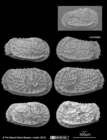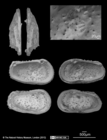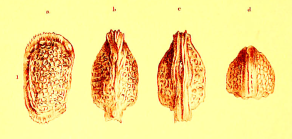WoRMS taxon details
Bradleya dictyon (Brady, 1880)
391268 (urn:lsid:marinespecies.org:taxname:391268)
accepted
Species
Bradleya dictyon dictyon (Brady, 1880) · unaccepted (raised to species level)
Cythere dictyon Brady, 1880 · unaccepted (superseded original combination)
Cythereis dictyon (Brady, 1880) · unaccepted (superseded combination)
Cythereis dictyon dictyon (Brady, 1880) · unaccepted (superseded combination)
Trachyleberis dictyon (Brady, 1880) · unaccepted (superseded combination)
- Subspecies Bradleya dictyon dictyon (Brady, 1880) accepted as Bradleya dictyon (Brady, 1880) (raised to species level)
marine, brackish, fresh, terrestrial
recent only
(of Cythere dictyon Brady, 1880) Brady, G. S. (1880). Report on the Ostracoda dredged by H.M.S. Challenger during the Years 1873-1876. <em>Report on the Scientific Results of the Voyage of H.M.S. Challenger during the years 1873–76. Zoology.</em> 1 (part 3): 1-184, pl. 1-45., available online at http://www.19thcenturyscience.org/HMSC/HMSC-Reports/Zool-03/README.htm [details] 
Type locality contained in Atlantic Ocean
type locality contained in Atlantic Ocean [details]
Description "Shell of the female, seen from the side, oblong, subquadrangular, not much higher in front than behind; height equal to...
Distribution "The records of [sic] Bradleya dictyon from the Southern Ocean by Neale (1967) and Hartmann (1989), were...
Distribution "The record of Bradleya dictyon from the southeast slope of the Pacific-Antarctic Ridge (48°45'S, 114°33'W, approximate...
Description "Shell of the female, seen from the side, oblong, subquadrangular, not much higher in front than behind; height equal to more than half the length; anterior extremity well rounded, fringed below the middle with numerous short teeth; posterior subtruncated, scarcely rounded, irregularly toothed on the lower half; the dorsal margin slopes gently from before backwards, and is always, in adult specimens, more or less irregularly jagged, while in some cases (figs. j and v) the indentations are remarkably deep; ventral margin more or less convex; seen from above, the outline is lozenge-shaped or somewhat hastate, about twice as long as broad, sides subparallel or converging gently towards the front, extremities broad and truncated; end view subtriangular, with convex margins and rounded angles. Shell surface covered with an irregular network of ribs, the main lines of which have often an obscurely radiate arrangement, originating in an obsolete central tubercle; just within and parallel with the ventral margin is a prominent, sharply-cut ridge, which is often produced behind the middle of the valve into a strong spine, but is continued in a less prominent style round the anterior and posterior portions of the shell, thus enclosing an elevated central area. The shell of the male is shown at figures e-g, and has usually a more strongly developed spinous armature than is seen in the female. Length, 1-25th of an inch (1 mm.).
I have thought it desirable to figure more copiously than usual some of the more remarkable forms, as well as various stages of growth, of this widely-distributed and variable species. Many intermediate varieties might have been added to those given in the plate, but a careful examination of these figures will, I think, be sufficient to show pretty conclusively the unity of the series. The ventral ridge is conspicuous even in the very youngest shells (r-u), and in these the surface-ornament, though much more delicate than in the adult, is sufficiently obvious; this character becomes increasingly distinct with the age of the animal, until in what appear to be the very oldest examples (U, v) the reticulations have become very massive and rounded by constant depositions of calcareous substance, while the intervening fossae are proportionally deepened. It is not uncommon to find the sculptured ornament of Ostracoda filled up and partly obliterated in old age; possibly this might be the case in still older specimens of Cythere dictyon than those which have come under my observation, but at present I have seen no trace of the obliterating process in this species. The tapering form of the valves in the earlier stages of growth is plainly shown in the plate, as also the absence or comparative feebleness of spinous armature. The adult varieties do not call for much remark; the spinous termination of the ventral ridge is seen in figures f, g, and i, and a marked difference of contour is apparent in the dorsal views (b, i); this may perhaps be dependent on growth, or possibly on distinction of race. I long hesitated as to whether or not the forms shown in figures j and v should be considered to belong to Cythere dictyon. The chief points of divergence are the very convex ventral margin, the contracted and strongly-indented dorsum, and (in figure v) the marked projection of the infero-posterior angle; I believe, however, that these conditions are mere exaggerations of characters which belong to the species, and which may be found developed with variable degrees of distinctness in different examples." (Brady, 1880: 99) [details]
I have thought it desirable to figure more copiously than usual some of the more remarkable forms, as well as various stages of growth, of this widely-distributed and variable species. Many intermediate varieties might have been added to those given in the plate, but a careful examination of these figures will, I think, be sufficient to show pretty conclusively the unity of the series. The ventral ridge is conspicuous even in the very youngest shells (r-u), and in these the surface-ornament, though much more delicate than in the adult, is sufficiently obvious; this character becomes increasingly distinct with the age of the animal, until in what appear to be the very oldest examples (U, v) the reticulations have become very massive and rounded by constant depositions of calcareous substance, while the intervening fossae are proportionally deepened. It is not uncommon to find the sculptured ornament of Ostracoda filled up and partly obliterated in old age; possibly this might be the case in still older specimens of Cythere dictyon than those which have come under my observation, but at present I have seen no trace of the obliterating process in this species. The tapering form of the valves in the earlier stages of growth is plainly shown in the plate, as also the absence or comparative feebleness of spinous armature. The adult varieties do not call for much remark; the spinous termination of the ventral ridge is seen in figures f, g, and i, and a marked difference of contour is apparent in the dorsal views (b, i); this may perhaps be dependent on growth, or possibly on distinction of race. I long hesitated as to whether or not the forms shown in figures j and v should be considered to belong to Cythere dictyon. The chief points of divergence are the very convex ventral margin, the contracted and strongly-indented dorsum, and (in figure v) the marked projection of the infero-posterior angle; I believe, however, that these conditions are mere exaggerations of characters which belong to the species, and which may be found developed with variable degrees of distinctness in different examples." (Brady, 1880: 99) [details]
Distribution "The records of [sic] Bradleya dictyon from the Southern Ocean by Neale (1967) and Hartmann (1989), were...
Distribution "The records of [sic] Bradleya dictyon from the Southern Ocean by Neale (1967) and Hartmann (1989), were misidentifications. Hartmann's and Neale's specimens are conspicuously higher in relation to length and show more sub-oval lateral outline (which is sub-rectangular in B. dictyon)." (Brady, 1880: 99) [details]
Distribution "The record of Bradleya dictyon from the southeast slope of the Pacific-Antarctic Ridge (48°45'S, 114°33'W, approximate...
Distribution "The record of Bradleya dictyon from the southeast slope of the Pacific-Antarctic Ridge (48°45'S, 114°33'W, approximate depth of water 2000 fathoms) by Benson (1964) was a misidentification of a Poseidonamicus species. (Brandao, S. N., pers. comm.)" (Brady, 1880: 99) [details]
Brandão, S.N.; Antonietto, L.S; Nery, D.G.; Pereira, J.S.; Praxedes, R.A.; Santos, S.G.; Karanovic, I. (2024). World Ostracoda Database. Bradleya dictyon (Brady, 1880). Accessed through: World Register of Marine Species at: https://www.marinespecies.org/aphia.php?p=taxdetails&id=391268 on 2024-11-21
Date
action
by
![]() The webpage text is licensed under a Creative Commons Attribution 4.0 License
The webpage text is licensed under a Creative Commons Attribution 4.0 License
original description
(of Cythere dictyon Brady, 1880) Brady, G. S. (1880). Report on the Ostracoda dredged by H.M.S. Challenger during the Years 1873-1876. <em>Report on the Scientific Results of the Voyage of H.M.S. Challenger during the years 1873–76. Zoology.</em> 1 (part 3): 1-184, pl. 1-45., available online at http://www.19thcenturyscience.org/HMSC/HMSC-Reports/Zool-03/README.htm [details] 
redescription Benson, R.H. (1972). The <i>Bradleya</i> Problem, with descriptions of two new psychrospheric ostracode genera, <i>Agrenocythere</i> and <i>Poseidonamicus</i> (Ostracoda: Crustacea). <em>Smithsonian Contributions to Paleobiology.</em> (12), 1-138., available online at http://si-pddr.si.edu/jspui/handle/10088/1879 [details] Available for editors [request]
[request]
new combination reference Hornibrook, N. B. (1952). Tertiary and recent marine Ostracoda of New Zealand, their origin affinities and distribution. <em>New Zealand Geological Survey, Paleontological Bulletin.</em> 18: 1-82. [details] Available for editors [request]
[request]
subsequent type designation Puri, H. S.; Hulings, N. C. (1976). Designation of lectotypes of some ostracods from the Challenger expedition. <em>Bulletin of the British Museum (Natural History). Zoology.</em> 29: 251-315.
note: Misapplication [details] Available for editors [request]
[request]
redescription Benson, R.H. (1972). The <i>Bradleya</i> Problem, with descriptions of two new psychrospheric ostracode genera, <i>Agrenocythere</i> and <i>Poseidonamicus</i> (Ostracoda: Crustacea). <em>Smithsonian Contributions to Paleobiology.</em> (12), 1-138., available online at http://si-pddr.si.edu/jspui/handle/10088/1879 [details] Available for editors
new combination reference Hornibrook, N. B. (1952). Tertiary and recent marine Ostracoda of New Zealand, their origin affinities and distribution. <em>New Zealand Geological Survey, Paleontological Bulletin.</em> 18: 1-82. [details] Available for editors
subsequent type designation Puri, H. S.; Hulings, N. C. (1976). Designation of lectotypes of some ostracods from the Challenger expedition. <em>Bulletin of the British Museum (Natural History). Zoology.</em> 29: 251-315.
note: Misapplication [details] Available for editors
 Present
Present  Present in aphia/obis/gbif/idigbio
Present in aphia/obis/gbif/idigbio  Inaccurate
Inaccurate  Introduced: alien
Introduced: alien  Containing type locality
Containing type locality
From editor or global species database
Description "Shell of the female, seen from the side, oblong, subquadrangular, not much higher in front than behind; height equal to more than half the length; anterior extremity well rounded, fringed below the middle with numerous short teeth; posterior subtruncated, scarcely rounded, irregularly toothed on the lower half; the dorsal margin slopes gently from before backwards, and is always, in adult specimens, more or less irregularly jagged, while in some cases (figs. j and v) the indentations are remarkably deep; ventral margin more or less convex; seen from above, the outline is lozenge-shaped or somewhat hastate, about twice as long as broad, sides subparallel or converging gently towards the front, extremities broad and truncated; end view subtriangular, with convex margins and rounded angles. Shell surface covered with an irregular network of ribs, the main lines of which have often an obscurely radiate arrangement, originating in an obsolete central tubercle; just within and parallel with the ventral margin is a prominent, sharply-cut ridge, which is often produced behind the middle of the valve into a strong spine, but is continued in a less prominent style round the anterior and posterior portions of the shell, thus enclosing an elevated central area. The shell of the male is shown at figures e-g, and has usually a more strongly developed spinous armature than is seen in the female. Length, 1-25th of an inch (1 mm.). I have thought it desirable to figure more copiously than usual some of the more remarkable forms, as well as various stages of growth, of this widely-distributed and variable species. Many intermediate varieties might have been added to those given in the plate, but a careful examination of these figures will, I think, be sufficient to show pretty conclusively the unity of the series. The ventral ridge is conspicuous even in the very youngest shells (r-u), and in these the surface-ornament, though much more delicate than in the adult, is sufficiently obvious; this character becomes increasingly distinct with the age of the animal, until in what appear to be the very oldest examples (U, v) the reticulations have become very massive and rounded by constant depositions of calcareous substance, while the intervening fossae are proportionally deepened. It is not uncommon to find the sculptured ornament of Ostracoda filled up and partly obliterated in old age; possibly this might be the case in still older specimens of Cythere dictyon than those which have come under my observation, but at present I have seen no trace of the obliterating process in this species. The tapering form of the valves in the earlier stages of growth is plainly shown in the plate, as also the absence or comparative feebleness of spinous armature. The adult varieties do not call for much remark; the spinous termination of the ventral ridge is seen in figures f, g, and i, and a marked difference of contour is apparent in the dorsal views (b, i); this may perhaps be dependent on growth, or possibly on distinction of race. I long hesitated as to whether or not the forms shown in figures j and v should be considered to belong to Cythere dictyon. The chief points of divergence are the very convex ventral margin, the contracted and strongly-indented dorsum, and (in figure v) the marked projection of the infero-posterior angle; I believe, however, that these conditions are mere exaggerations of characters which belong to the species, and which may be found developed with variable degrees of distinctness in different examples." (Brady, 1880: 99) [details]
Distribution "The records of [sic] Bradleya dictyon from the Southern Ocean by Neale (1967) and Hartmann (1989), were misidentifications. Hartmann's and Neale's specimens are conspicuously higher in relation to length and show more sub-oval lateral outline (which is sub-rectangular in B. dictyon)." (Brady, 1880: 99) [details]
Distribution "The record of Bradleya dictyon from the southeast slope of the Pacific-Antarctic Ridge (48°45'S, 114°33'W, approximate depth of water 2000 fathoms) by Benson (1964) was a misidentification of a Poseidonamicus species. (Brandao, S. N., pers. comm.)" (Brady, 1880: 99) [details]




